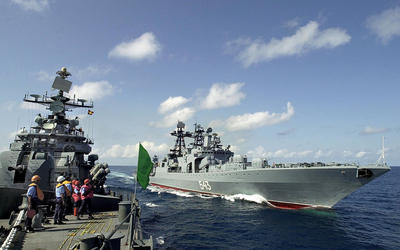This is particularly true in the context of the struggle for gaining maritime influence in the region.
The ‘activity’ in the Indian Ocean region is defined by extensive trade, energy transfers and a spectrum that ranges from political turbulence on one end, to threats from piracy, terrorism and transnational crime on the other. Most importantly, it is an area that has become witness to a jostle for power, and subsequent shifts in the dynamics of the region.
This struggle has intensified as a consequence of the ‘imperial overstretch’ of US forces, and a commonly perceived erosion of US influence. There is growing participation in the area from other major players seeking primacy along with the US. The new players are primarily India and China, with Australia, Indonesia and South Africa occasionally playing the role of aspirant kingmakers.
The region has become ripe for geostrategic competition due to the presence of mutually distrustful littorals, who have prevented the creation of an overall security architecture, despite similar priorities and a common interest in maritime operations. Multilateral forums, such as the Indian Ocean Rim Association for Regional Cooperation (IOR-ARC), formed in March 1997, have an economic agenda and are presently widely considered moribund. The fate of numerous regional or sub-groupings is better in some cases as they cater exclusively to regional aspirations.
Given the atmospherics, India — with its large maritime capacity — has attempted to play the role of an ‘unobtrusive fulcrum’ and a ‘balancer of power’ in the region. It created the Indian Ocean Naval Symposium (IONS) in 2008 with enthusiasm from all participating littorals. Unfortunately, the focus of the movement seems to have diffused now, while it meanders along with its meetings — the most recent one held in the United Arab Emirates.
China has been making increased forays into the Indian Ocean Region(IOR) in the interests of energy security and trade. Spiralling demand for energy from India, China and Japan has led to an inevitable and enhanced sensitivity around the security of the Sea Lines of Communication (SLOCs) and of choke points which dot the entrances of the Indian Ocean. After all, at current levels of consumption, India’s oil import dependence is expected to rise to 91.6 per cent by 2020, while in the case of China it will be 76.9 per cent. With large volumes of energy and trade for China coming from West Asia and Africa, it is inevitable that the Chinese will attempt to ensure Indian Ocean SLOC security.
While the Chinese have made inroads into Pakistan (Gwadar), Sri Lanka, Myanmar, the Indian Ocean Islands and Bangladesh as part of its ‘string of pearls policy’ of encirclement, India has been trying to cast its strategic net well beyond the region. It is actively pursuing a multi-pronged response strategy, which seeks to neutralise Chinese influence in its immediate neighbourhood while simultaneously courting states on its periphery, many of which are apprehensive of creeping Chinese aggressiveness.
Elevating bilateral relations with South Korea to a strategic partnership, a strategic dialogue with Japan and quiet support for the Vietnamese on the South China seas are all part of the Indian design. Focused attempts at enhancing its political-military relations with Singapore, Indonesia, the Philippines and Myanmar, are all part of this process.
Bangladesh, along with Indian Ocean islands, and East African states have also been on the receiving end of Indian largesse in various forms. Moving further westward, India has been strengthening its economic, security and diplomatic relationship with Iran, not only to neutralise Pakistan but also to checkmate the Chinese hold on Gwadar port.
The growing incidents of piracy emanating from the failed state of Somalia and the semi- autonomous Puntland have strategic implications for the ongoing struggle. The naval melee of various task forces and warships acting independently in the region has thrown up strategic lessons and questions. The Chinese naval deployment in this field not only reinforces its strategic reach and sustenance capability, but also displays its capacity to act swiftly and flexibly.
With the tacit agreement of the US, which insists on India’s large and capable maritime force playing a larger role in Indian Ocean politics — and given the China threat factor, which looms large in minds of small and large nations alike — it is likely that India will enhance its influence in the region. India’s strategic ethos will, however, mean that it will insist on taking important friends like Australia, South Africa and Indonesia along in this process for greater development of the region.
Probal Ghosh was Coordinator of the IONS 2008 inaugural seminar and helped in conceptualising the initiative. Currently he is a Senior Fellow at the Observer Research Foundation, (ORF) India. He is also the Co- Chairman of the CSCAP International Study Group on Maritime Security (Naval Enhancement).

